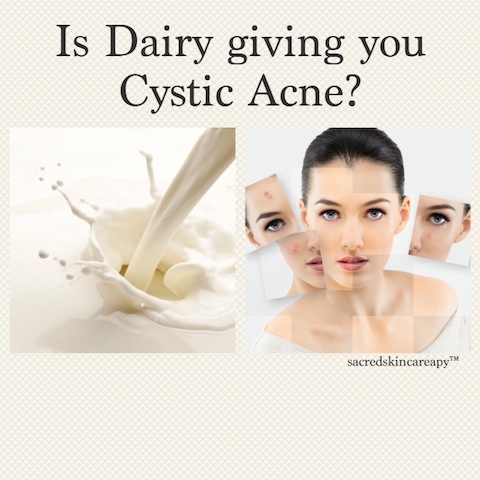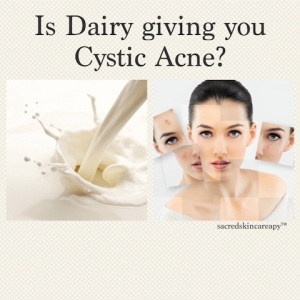Now more than ever we’re realizing the impact on our health by the foods we use to fuel and fill our bodies. We’re learning the importance of foregoing prepackaged, preservative-dense foods and choosing low-glycemic, vitamin, mineral & protein rich options that make us feel great from the inside out.
When it pertains to acne, it’s a no-brainer that the foods we eat are often part of the equation that results in blemishes in the skin. Think about it. The foods we eat affect so many of our body systems and organs; the skin is the largest organ of the body — what we put in, must come out and when are bodies are breaking down foods through digestion (70% of your body’s immune system is in your intestinal tract), occasional (or frequent) disagreements reveal themselves in our skin.
Got Milk?
Cystic breakouts (those hard, painful, underground blemishes that linger for weeks) on the chin, jaw line and neck area are often a sign that your dairy intake is more than your body can handle.
The reason this often painful skin purging happens is a result of the pregnancy hormones in dairy cows.
Dairy cows are usually doing two things for the span of their lives: birthing calves and milking.
Pregnant dairy cows are naturally producing hormones. Just like humans, these hormones produce at higher levels during ovulation and pregnancy. Most women are familiar with PMS and the causes (hormones) so now imagine for a minute if you were in a constant state of pregnancy and giving birth. Yikes, right?
With this higher state of hormones, it makes sense that dairy consumption can disrupt our own hormones.
All About Androgens
Androgens are male hormones that are made by the testes in males and by the adrenal gland in females. Androgens are endocrine hormones. Major endocrine glands include the pituitary gland, pancreas, ovaries, testes, thyroid, hypothalymus, gastrointestinal tract and adrenal glands. These hormones flow directly into the bloodstream.
Androgens act as a stimulant for sebaceous glands (oil glands in the skin) causing them to produce oil. So it makes sense that too many androgens cause overstimulation of the oil glands, leading to acne breakouts.
The DHT in milk is an androgen hormone that wrecks havoc on skin oil glands by causing an overproduction of oil.
Your skin acts as an excretory system to flush what your body doesn’t agree with. In general, dairy products can be extremely difficult to digest (that wine & cheese night? Sounds awesome until constipation sets in) and the “flushing” can result in skin purging in the form of cystic blemishes in the lower area of the face.
Sacred Skin Tip: The best way to determine if your acne cysts are directly related to dairy intake is to completely cut dairy out of your diet for 30 days.
Cutting out dairy is a great way to help pinpoint a cause of acne. If you don’t develop any new cystic blemishes in the first few weeks then you’ve likely discovered the culprit. I always recommend 30-40 days to help your skin cycle through possible new breakouts and heal from existing breakouts.
But before you bid frozen yogurt adieu and toss the penne with cream sauce in the trash, this doesn’t mean that you can’t eat any dairy anymore – ever.
The best gauge is to slowly introduce dairy back into your diet and keep a daily food journal as you do so. If you start breaking out again you’ll have an idea of your body’s tolerance level.
For some, giving up dairy completely and abruptly can seem challenging. We don’t even think about the many foods that contain dairy. Along with the obvious milk, cheese and yogurt, there’s also cream, butter, sour cream, cream cheese, many sweets like cookies and cake that contain milk, milk chocolate, pastas, pizza, cereals, as well as protein powders & supplements that contain whey and casein.
Luckily, we live in a time where dairy substitutions are a lot easier to find in local and national chain-typel markets. Almond, rice, and hemp milk are all alternatives for milk. There are lots of soy options available, though I caution against too much soy consumption as soy can sometimes cause hormonal disturbances, also, due to isoflavones (plant estrogens). Too much estrogen tips the balance towards what again? Yep, androgens.
Keep in mind there are several factors to take into consideration when you’re experiencing acne and diet is just one. Genetics, stress, certain medications, and products are also factors.
Have you eliminated dairy and noticed a change in your skin? Post in the comments below.


